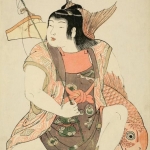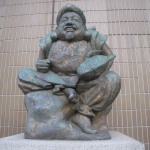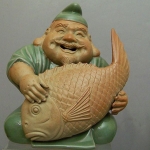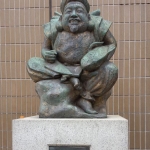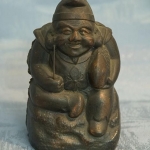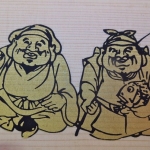Ebisu
from the shadow
of food offerings
the God of Wealth peeks out
–Issa
Popular among fishing folk, sailors, farmers, and people in the food industry, the smiling and often bearded Ebisu is commonly shown wearing formal court garments or the hunting robes of a courtier, but his main attributes are the fishing rod in his right hand and a large red sea bream or a red snapper dangling from the line or tucked under his left arm. In Japan, these two fish symbolize fortune. Ebisu is also depicted wearing a pointed hat folded in the middle, which was worn by courtiers of the imperial court in olden times. Less commonly, Ebisu is depicted carrying a folding fan rather than a fish or fishing rod. The meaning of the fan is unclear, but it no doubt symbolizes the granting of wishes or making of judgments — in olden times, the fan was waved by the emperor in a certain direction to indicate either acceptance or rejection of a request during the emperor’s audiences with nobles and commoners.
In a nation fond of fish, Ebisu is not surprisingly one of the most popular of the Seven Lucky Gods. Ebisu is also the only deity among the seven to originate in Japan. Today he symbolizes not only safe sailing and plentiful fishing, but business prosperity for merchants in all trades and success to people in any occupation. In artwork, Ebisu is often paired with Daikoku (Hindu origin; god of agriculture and rice). Indeed, in some traditions, Ebisu is considered the son of Daikoku. Statues of the pair can be found everywhere in modern Japan — the two together are perhaps the most popular motif of good luck nationwide. The Ebisu-Daikoku duet are also enshrined in kitchens, especially in farming communities.
Ebisu is worshipped at numerous sanctuaries. At Nishinomiya Jinja (Hyogō Prefecture), the head shrine of Ebisu worship in Japan, it is said that Ebisu is rather deaf. Thus arose, says the shrine, the widespread custom of clapping hands before one prays to shrine deities in order to gain the attention of the gods. In January and October each year, many localities still celebrate the Ebisu-kō (Ebisu Festival), during which local merchants, shops, and department stores give special discounts. The Ebisu-kō tradition originated sometime in the early Edo period as a way to alleviate the guilty conscience of merchants who bought cheap and sold high. Since Ebisu is the God of Fair Dealing, merchants apparently began offering bargain sales as a penance and apology to Ebisu.
Worship of Ebisu became very popular during the Edo period, when Ebisu dolls were mass-produced and sold throughout the countryside by traveling Ebisu puppeteers (ebisumawashi or ebisukaki) mainly from Nishinomiya in Hyougo Prefecture. Dolls or portraits were used by believers at festival rites, ebisukou, held on October 20th (or in January in some regions) to celebrate Ebisu and pray for prosperity.
Toka Ebisu
The first major festival of the year in Kyoto is Toka Ebisu. “Toka” means the tenth day, and Ebisu is the god of good fortune and prosperity. Though centered on the 10th of January, this festival actually lasts for five days from the 8th until the 12th. During this time thousands of visitors crowd into Ebisu-jinja to conduct a simple ritual of prayer for ongoing success in their work and business.
Many people buy branches of lucky bamboo grass, called Fuku-Zasa which has been blessed in a special ritual by a shrine maiden. They then buy more lucky charms and talismans, which they attach to the bamboo branch. These charms come in all kinds of designs, but two of the most common are treasure boats for wealth and red sea bream for future success.
When you reach the main altar, throw a coin into the donation box. A five yen piece is considered lucky but any coin will do. Step back and then perform the following simple ritual.
* Bow twice deeply.
* Clap twice.
* Spend a moment in prayer.
* Bow once again.
Ebisu is thought to be hard of hearing, so after praying people file past a wooden board to the left of the main altar and knock on it as they go by. This is said to wake Ebisu up and get him to pay attention to your prayers.
Throughout the festival, shrine maidens perform a ritual dance called kagura. This simple dance to pipe and drum has its roots in ancient shamanic rites held to summon the gods. At Ebisu Festival it is performed to purify and bless the lucky branches of bamboo grass. When sales of these branches are slow, the dances take place every fifteen to twenty minutes, but as the shrine gets busier the dance is performed almost continuously.
Toka Ebisu is also a good opportunity to see maiko, the apprentice geisha or geiko of Kyoto. On the afternoon of January 11th, maiko from the geiko district of Gion sit in the main hall and give out lucky rice cakes and branches of lucky bamboo grass. In the evening maiko from the Miyagawa district do the same.


